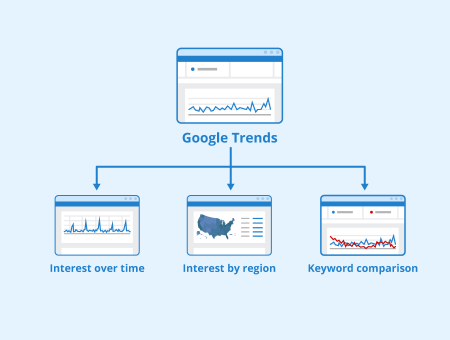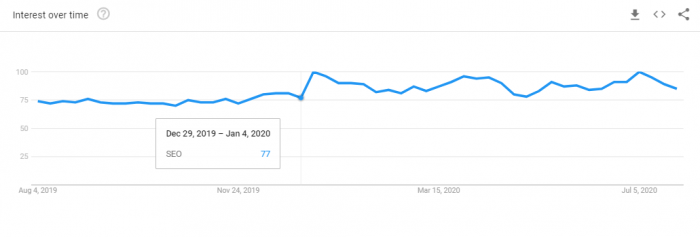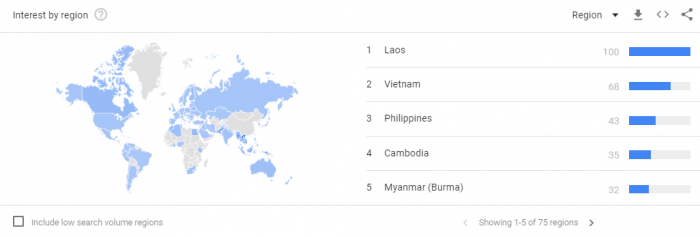What is Google Trends?

Google Trends is a service provided by Google and its main function is to analyze and compare data related to search queries. This online tool was launched in 2006 to give users insights into user behavior and into their main interests by comparing the volume of searches over time and in specific areas.
The service is available in every language supported by Google and is free of charge. The data gathered by this tool are kept anonymous since no names or other personal information of the user behind each search are revealed.
Google’s service also provides information on topics and queries related to the keyword in question for a more global view of user interests.
Google Trends users can subscribe to an automated service that sends email updates on specific keywords on a weekly or monthly basis, which eliminates the need to carry out searches manually.
How does Google Trends work?
Google Trends has a format similar to a search engine. Users can search for trends by typing in the desired keyword, search term, or topic. This will display a graph that represents the online interest in that keyword over a period of time and for a specific region. Interest is rated on a scale of 0 to 100, with 100 suggesting peak popularity or highest search volume and 0 indicating there is not sufficient data available on that keyword. For example, a keyword with a score of 50 does not indicate that the keyword has been searched 50 times, but rather a mid-range level of popularity.
The data is obtained by comparing how often a given search term is typed into Google Search to the total number of inquiries made on that same engine.
Some exclusions apply (i.e. some searches are excluded). This is the case of duplicate searches, such as those made by the same user or IP in a short time frame, searches that include special characters, and low volume queries.
Google Trends also provides sets of compiled data, such as recently trending searches and top trending keywords by year. Any data obtained via Google Trends can be downloaded in CSV format, embedded in another site, or shared, all from the main interface.
In the main interface, the data are presented according to two criteria: interest over time and interest by region.
Interest over time
Google Trends captures online interest in certain keywords or topics over a given period of time. There are two types of time-bound data available:
- Real-time data, which offers insights into the 7 days prior to the search.
- Non-real-time or historical data, which traces searches done as far back as the early 2000s.
For real-time data, it is also possible to select short time frames, such as the hour previous to the search.
The following figure shows that the search term “SEO” reached 77% of its maximum search volume in the last 12 months between Dec 29, 2019, and Jan 4, 2020. The maximum value in this period was reached in the week of Jan 5 – Jan 11 2020 and was therefore set to 100.

Screenshot with “interest over time” for the term SEO of trends.google.com
Interest by region
The interest by region feature indicates in which regions a specific keyword is popular. Regional data are also compared to total search volumes, and the scores do not have intrinsic quantitative meaning (see paragraph 1 in Section 2 “How does Google Trends work?”).
The data can be filtered by country, although it is possible to get a view of how certain searches are performed at a global level via the ‘Worldwide’ filter.
The tool also has a sub-region setting for each country, so that results can be further refined by selecting the relevant area, whether it is a province or a city.
For the interest by region view, the number of search queries for a term within a specific region is determined relative to the total volume of all search queries within the region (over a certain time period).
The region with the highest relative volume then receives a score of 100 and all other countries are scaled down accordingly. For example, a search term has an absolute search volume of 50,000 in Region A and an absolute search volume of 100,000 in Region B. The total number of all search queries this month is five million in Region A and 20 million in Region B. The relative popularity of the term is therefore 50,000/5,000,000=0.01 in region A and 100,000/20,000,000=0.005 in region B. Since the figure in region A is the highest in this simplified example, this region receives a score of 100 and region B a score of 50 since it reaches half of the relative popularity in region A.

Screenshot showing “interest by region” of trends.google.com
Features and importance for SEO
The data provided by Google Trends can be of great help for SEO and online marketing. The main purpose of this tool is to offer insights into which topics are of interest to the public, so you can use this information to determine where to market your business with more chances of success.
Google Trends can also be used for keyword research since it allows for a very granular analysis of current keyword trends, which has an obvious application in developing targeted website content. For example, the related topics and keywords feature is useful to inform a content creation strategy that reaches a wider audience.
The related topics feature is also handy for businesses looking to respond to customer needs in real-time. With this information, business owners can develop new products, services, or categories related to their business that attract traffic to their websites and tap into existing customer needs.
Another useful feature is the ability to search data by channel within all Google products, including the main search engine, YouTube, Google Images, Google News, and Google Shopping. Keyword trends found here can be helpful for developing a marketing strategy targeted at these specific channels.
Interest over time data may reveal seasonal patterns or preferences so that products, services, and online content can be adjusted accordingly to match user expectations. This information can also be used to ensure content is fresh and relevant to current needs, helping this content rank higher.
Similarly, interest by region data can help discover niches in new markets, or guide business expansion efforts by targeting areas with a proven interest in certain products or services. Geographic trends are also useful to power a local SEO strategy.
The combination of these two features (interest over time and interest by region) can help business owners develop a powerful online strategy that relies on personalized and timely offerings.
Google Trends can also be used to compare how different topics or keywords are performing. The compare feature comes in handy when deciding which items or services are worth promoting, prioritizing, or investing in. This feature can be applied to competitor research too.
Overall, Google Trends is a useful online tool when it comes to leveraging detailed information that can help understand market dynamics.
Related links
- Keyword Research And Analysis: How To Find The Best Keywords For Your Website – Seobility Blog
- https://support.google.com/trends/answer/4365533?hl=en&ref_topic=6248052
Similar articles
